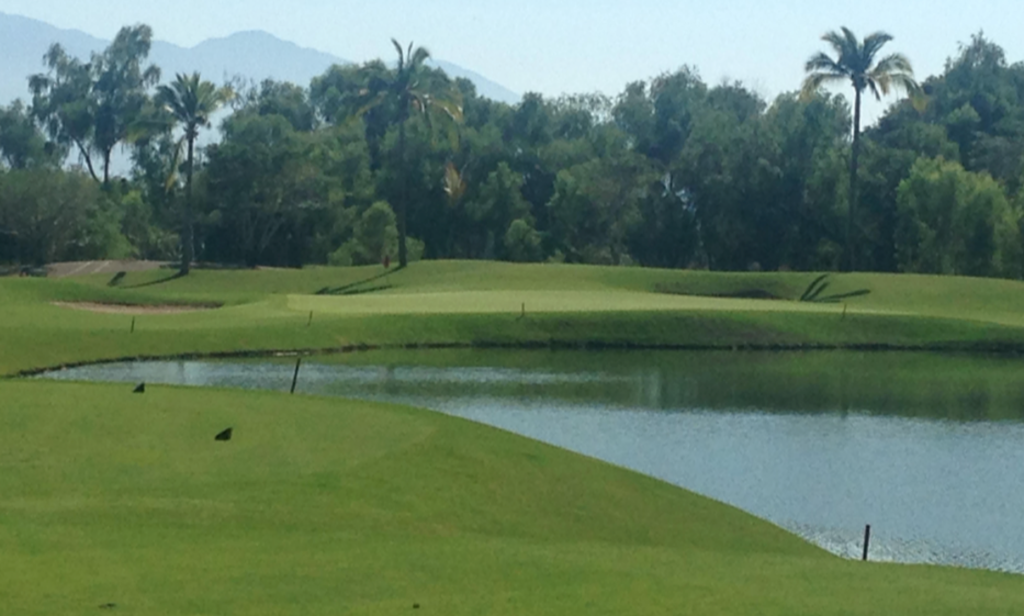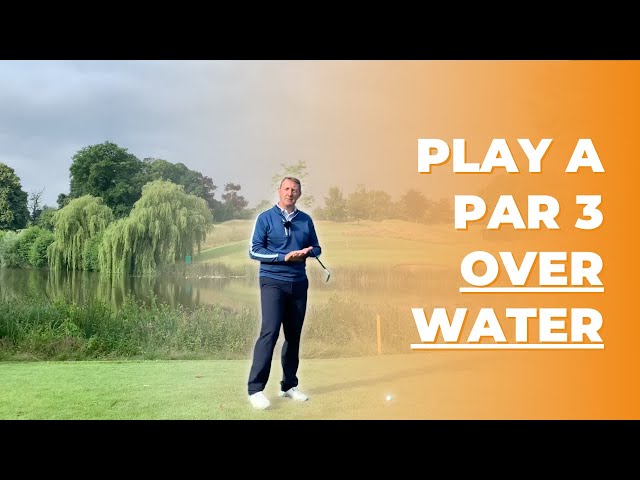Picture yourself standing on the tee box, the sun shining down on a beautifully manicured golf course. As you look ahead, you see a par-3 hole with a menacing water hazard that lies between you and the green. The question on your mind is clear: what is the best strategy to conquer this challenging hole? In this article, we will explore some expert tips and insights to help you navigate a par-3 with water, ensuring that you can confidently swing your way to success. So grab your clubs and let’s discover the winning approach together.

Club Selection
Assessing the Distance
When facing a par-3 hole with water, the first step in determining the best strategy is to assess the distance to the pin. To do this accurately, take into account the distance markers on the course and use a distance-measuring device if available. By knowing the exact distance, you can select the appropriate club to reach the green without risking a water hazard. Keep in mind that wind and other factors may also influence the choice of club.
Considering the Wind
In addition to distance, taking the wind into consideration is crucial when facing a par-3 with water. Strong winds can affect the trajectory and carry of your shot, potentially leading to a disastrous outcome if not accounted for. Before deciding on a club, assess the wind direction and speed. Consider how the wind might influence the flight of the ball and adjust your club selection accordingly. A tailwind may require a slightly shorter club to prevent overshooting, while a headwind may call for a bit more power to reach the green.
Choosing the Right Club
After assessing the distance and considering the wind, it’s time to choose the right club for the shot. The key here is to select a club that allows you to reach the green comfortably, accounting for any potential wind and water hazards. It’s generally better to err on the side of caution and choose a club that will leave you with a shorter putt, rather than risking the water by being overly aggressive with your club selection. Remember, it’s not just about reaching the green, but doing so with control and minimizing the chances of ending up in a hazard.
Shot Placement
Identifying the Pin Position
Once you have selected the appropriate club, it’s important to assess the pin position on the green. Pin placement can greatly affect your shot strategy, as it determines the ideal landing area for your shot. Take note of whether the pin is positioned in the front, middle, or back of the green. A pin placement closer to the water may require you to aim slightly away from it to ensure you don’t inadvertently end up in the hazard. Conversely, a pin placement away from the water may allow you to be more aggressive with your shot, aiming directly at the pin.
Avoiding Water Hazards
One of the biggest challenges when facing a par-3 with water is to avoid the water hazard altogether. To do this, it’s crucial to have a clear understanding of the layout of the hole and the precise location of the water hazard. Take note of any bunkers, slopes, or other obstacles that could potentially redirect your shot into the water. By maintaining a conservative and well-planned shot placement strategy, you can significantly reduce the risk of finding your ball in the water and save strokes on your scorecard.
Landing the Ball in a Safe Area
In addition to avoiding the water hazard, it’s important to aim for a safe area on the green. Landing the ball in a safe area refers to selecting a target on the green where you can comfortably putt without obstacles or challenging breaks. Even if you don’t manage to hit the green directly, aiming for a safe landing area nearby can still give you a good chance to minimize the damage and recover with a well-executed chip or pitch shot. Analyze the green’s contours, slopes, and any potential ledges or plateaus that could affect your shot.
Shot Strategy
Playing Safe
Playing safe is often a smart strategy when facing a par-3 with water. This means selecting a club and shot type that ensures you stay away from water hazards and instead positions you in a more forgiving area on the green. By taking a conservative approach, you minimize the risks and increase your chances of making a solid, controlled shot. This strategy may involve using a slightly shorter club to ensure a safe landing or aiming for the center of the green rather than going directly for the pin.
Attacking with Precision
While playing safe can be a reliable strategy, there are times when taking a more aggressive approach can yield rewards. Attacking the flag with precision requires confidence and the ability to execute your shots accurately. This strategy is more suitable for experienced golfers who are comfortable with taking calculated risks. If the pin position allows for it and you are confident in your ability to clear water hazards, aiming directly at the pin can result in shorter putts and even birdie opportunities. However, be aware of the potential consequences if your shot doesn’t go as planned.
Considering the Risk-Reward Ratio
When deciding between playing safe or attacking with precision, it’s crucial to consider the risk-reward ratio. Evaluate the potential rewards of a more aggressive shot against the risks involved. If the potential reward is not significantly greater than the risk of ending up in the water, it may be wiser to opt for a safer strategy. Remember that minimizing mistakes and making consistent, smart decisions can often lead to better overall scores. Analyze your skill level, the conditions, and the situation before deciding on your shot strategy.
Preparation
Mental Approach
A strong mental approach is essential when facing a par-3 with water. Before stepping up to the tee, take a moment to focus and clear your mind. Visualize a successful shot and believe in your ability to execute it. Confidence plays a crucial role in your performance, so cultivate a positive mindset and trust in your preparation. It’s also important to accept that mistakes can happen and to maintain a resilient attitude in the face of challenges. Use positive self-talk and remind yourself of past successful shots to boost your confidence.
Visualizing the Shot
Visualization is a powerful technique that can improve your shot execution. Take a moment to visualize the shot you want to make, from the initial setup to the ball’s trajectory and landing. Imagine the ball soaring over the water hazard and landing safely on the green. Visualizing success can help calm your nerves and increase your focus and commitment to the shot. By practicing this mental exercise, you prepare your mind and body to execute the shot with greater precision and confidence.
Controlling Nerves
Nerves are a natural part of golf, especially when faced with challenging shots like a par-3 with water. To control your nerves, it’s important to focus on your breathing and establish a pre-shot routine that helps calm your mind and body. Deep breaths and a consistent routine can help create a sense of familiarity and relaxation, allowing you to execute your shots more effectively. Remember that nerves are normal, and it’s how you manage them that can make a difference in your performance.

Analyzing the Green
Checking Slope and Slope Direction
Analyzing the slope of the green is crucial when planning your approach on a par-3 hole with water. Look for any noticeable slopes or changes in elevation that could affect the roll and break of your putt. Understanding the slope direction can guide your decision-making process, helping you select the ideal line and speed for your putt. Taking the time to observe the green’s contours ensures that you have a better chance of executing your putt successfully, even when faced with challenging pin placements.
Reading the Greens
Reading the greens is an art that can greatly impact your putting performance. Look for subtle changes in color and texture that indicate slopes and breaks. Indentations or ball marks left by previous players can provide clues about the speed and direction of the putt. Pay attention to the surroundings of the green as well, as trees and nearby hazards can affect the overall slope and break. Take your time to analyze the green from multiple angles, and trust your intuition when deciding on your putting line.
Identifying Ledges or Plateaus
Identifying any ledges or plateaus on the green is crucial in planning your shots on a par-3 with water. These features can significantly impact your strategy, especially when the pin is located near them. Take note of any elevated areas or sudden drops that could affect the trajectory and roll of your shot. By knowing where these ledges or plateaus are, you can adjust your shot aim and club selection accordingly to maximize your chances of getting close to the pin without risking falling short or rolling into the water.
Accounting for Water Hazards
Understanding Water Carry Distances
Understanding the water carry distances is essential when facing a par-3 with water. These distances refer to the length of your shot required to clear the water hazard and reach the green safely. To determine the water carry distance accurately, consult course maps, yardage charts, or use a distance-measuring device if available. Knowing your individual water carry distances for each club in your bag allows you to make informed decisions on club selection and shot strategy. Practice and experience will help refine and improve your accuracy in identifying these distances.
Analyzing Water Hazards Placement
When strategizing for a par-3 with water, take the time to analyze the placement of the water hazards on the hole. Identify any narrow or wider sections, significant drops, or other features that may affect your shot. By understanding where the hazards are located, you can plan your shot to avoid them and instead position yourself in a more favorable area for your next shot. Remember that being aware of the hazards and adjusting your strategy accordingly can save you valuable strokes and increase your chances for success.
Identifying Bailout Options
No matter how skilled a golfer you are, there will always be moments when things don’t go as planned. To prepare for such situations on a par-3 with water, it’s important to identify bailout options. A bailout option refers to a safer area you can aim for to avoid potential water hazards if your shot doesn’t go exactly as intended. These areas may be located on the side of the green or slightly further away from the pin. By having a backup plan, you can minimize the consequences of a less-than-perfect shot and increase your chances of recovering with a manageable next shot.

Shot Execution Tips
Finding a Good Setup Position
Shot execution begins with finding a good setup position. Take the time to align your body and clubface properly, ensuring that your feet, shoulders, and hips are parallel to the target line. Aim slightly away from the water hazard if needed, while still considering the pin position and overall shot strategy. Maintain a relaxed posture, with your weight evenly distributed between your feet. A good setup position sets the foundation for a well-executed shot and increases your chances of making solid contact with the ball.
Maintaining a Smooth Tempo
When executing a shot on a par-3 with water, it’s important to maintain a smooth tempo throughout your swing. Rushing or forcing your swing can lead to poor contact and inaccurate shots. Focus on maintaining a consistent rhythm, starting with a smooth backswing and following through with a controlled finish. Remember that power comes from the acceleration of the club, not from swinging harder. By controlling your tempo, you can improve your shot quality and reduce the chances of hitting the ball into the water hazard.
Avoiding Tension in the Grip
A proper grip is essential for a successful shot execution. Avoid gripping the club too tightly, as it can lead to tension and restrict your range of motion. Instead, maintain a comfortable grip pressure that allows for a free and fluid swing. A lighter grip promotes better wrist action and overall clubhead control. By avoiding tension in the grip, you can ensure a smoother swing and increase your chances of making clean contact with the ball, minimizing the chances of a wayward shot finding its way into the water hazard.
Using Course Knowledge
Reviewing Previous Rounds
One of the benefits of playing a course multiple times is the ability to review previous rounds and learn from your experiences. Take note of the clubs and shot strategies you’ve used successfully on similar par-3 holes with water in the past. Recall the areas that have caused you trouble or led to water hazards and avoid repeating the same mistakes. Course knowledge can provide valuable insights and confidence, allowing you to make informed decisions on club selection and shot strategy that have worked well for you in the past.
Learning from Other Players
Another way to enhance your understanding of the best strategy for a par-3 with water is to learn from other players. Observe how more experienced golfers navigate these challenging holes and take note of their shot selection and execution. Pay attention to their shot placement, club choices, and strategies. Engage in conversations with fellow golfers who have played the course before, seeking their advice and insights on how to approach par-3s with water. Learning from others can provide valuable perspectives and help you refine your own strategy.
Recognizing Patterns and Trends
Take the time to recognize patterns and trends on the course, specifically regarding par-3 holes with water. Certain golf courses may consistently have water hazards positioned in similar areas or exhibit common pin placements. By recognizing these patterns, you can create a mental map that guides your strategy and shot selection. Look for trends in how wind affects the direction and carry of your shots, and adapt your game accordingly. Paying attention to these details can give you an edge in understanding the course and making more informed decisions throughout your round.

Importance of Focus
Staying Present in the Moment
Maintaining focus and staying present in the moment is crucial when facing a par-3 with water. It’s easy to get distracted by the potential hazards and the pressure of making a good shot. However, allowing your mind to wander diminishes your ability to execute your shots effectively. Stay focused on the task at hand, clearing your mind of any distractions. Remind yourself to take one shot at a time, focusing solely on the process rather than the outcome. By staying present in the moment, you increase your chances of making a confident and successful shot.
Eliminating Distractions
Eliminating distractions is a key aspect of maintaining focus on a par-3 with water. Before taking your shot, take a moment to scan the surroundings and identify any potential distractions. This could include spectators, noise from other players, or nearby activities on the course. Find a way to block out these distractions, whether it’s through mental exercises like visualization or creating physical barriers to shield yourself from external factors. By intentionally eliminating distractions, you can improve your concentration and increase your chances of executing a successful shot.
Fostering Concentration
Concentration is the foundation of focus on a par-3 with water. Fostering concentration involves training your mind to remain fully engaged and attentive to the task at hand. One effective technique is to establish a pre-shot routine that helps you enter a focused state before each shot. This routine could involve taking a deep breath, visualizing the shot, and reaffirming your chosen strategy. Additionally, practicing mindfulness and meditation techniques off the course can contribute to strengthening your ability to concentrate under pressure. By fostering concentration, you enhance your mental clarity and improve your overall performance on challenging par-3 holes with water.
Course Management
Considering Risk Tolerance
Course management encompasses a wide range of decisions made throughout a round of golf, especially on challenging holes with water hazards. When formulating a strategy for a par-3 with water, it’s vital to consider your personal risk tolerance. Assess the potential risks and rewards of each shot option, taking into account your skill level and overall goals for the round. If you tend to be more conservative and prefer to minimize mistakes, a safer, more strategic approach may be the best choice. However, if you thrive on taking calculated risks, you may opt for a more aggressive strategy. Knowing and understanding your risk tolerance can guide your decision-making process and lead to more favorable outcomes.
Strategizing for Different Wind Conditions
Wind conditions play a significant role in course management, especially on par-3 holes with water. Being aware of wind direction and strength helps you adjust your shot strategy to increase the chances of a successful outcome. If facing a headwind, selecting a slightly longer club and taking a more aggressive line to combat the wind may be necessary. Conversely, a tailwind could require a shorter club and an adjustment in aiming to prevent overshooting the green. Continuously monitoring and strategizing for different wind conditions provides a competitive advantage and contributes to effective course management.
Deciding on Aggressive or Conservative Play
When formulating your overall course management strategy, deciding on whether to play aggressively or conservatively is a critical factor. Choosing to play aggressively often involves taking calculated risks, aiming for tight landing areas and pin positions despite potential hazards. This approach can lead to lower scores and more birdie opportunities. On the other hand, playing conservatively focuses on minimizing mistakes and avoiding hazards, aiming for safer landing areas and being content with longer putts for par. The decision between aggressive and conservative play depends on your skill level, overall score goals, and the specific circumstances of each hole. Evaluating the risk-reward ratio and considering your competence in executing different shots are vital in making the best decision for your game.
In conclusion, successfully navigating a par-3 hole with water requires careful consideration of various factors. Assessment of distance and wind, choosing the right club, and understanding shot placement are critical. Preparation, controlling nerves, and analyzing the green contribute to effective decision-making. Accounting for water hazards, executing shots skillfully, and leveraging course knowledge provide a competitive edge. The importance of focus, sound course management, and determining the appropriate risk-reward ratio complete the comprehensive strategy for tackling par-3 holes with water. By implementing these principles, you can approach these challenging holes with confidence and increase your chances of success on the golf course.







